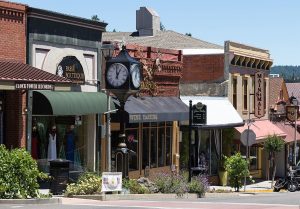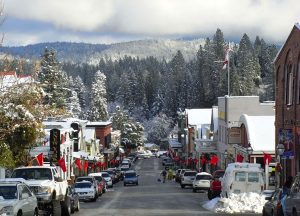There’s Gold to Be Discovered!
Residing at the foundation of Communities Collaborating is a commitment to appreciation. The distinctive mission of Communities Collaborating concerns the way in which participating communities find their own “gold” – the distinctive value inherent in their own community. Our mission also is about extracting this gold from the ground and making full use of it. As members of Communities Collaborating, in alliance with colleagues in our communities, we act as “prospectors” who are there to “discover” the gold nuggets and extract these nuggets from the ground and bring wealth to our communities.
The “gold” is what we call community capital. It can come in the form of natural resources or in the form of history and culture. Most importantly, this community capital is to be found and engaged in the commitment of people in our communities to the sharing of their time and expertise on behalf of the life and welfare of their fellow citizens.
Our three founding communities have been blessed with abundant “gold”. In the case, of Nevada City and Grass Valley, it is literally gold – they are communities that were founded during the California gold rush of 1849. The life of these two communities is still filled with the spirit of rugged individualism and energetic engagement with nature and fellow seekers of new opportunities. As portrayed in the Lerner and Lowe musical, Paint Your Wagon, our two Nevada County communities are filled with those who are following “the wandering star.”
For Harpswell, the gold is lobsters. This community is made up of a series of islands, sheltered coves and shore lines. Off shore, there are lobsters! And the bays and inlets are filled with lobster traps and lobster boats. Restaurants featuring lobsters are to be found in abundance. To paraphrase Rogers and Hammerstein, who wrote about life in the Harpswell area in their musical, Carousel, this New England community is “busting out all over” with lobster.
In both Nevada County communities and in Harpswell, there is an abundance of history and culture. A Harpswell meeting house that was the location where plans were laid for the American revolutionary war. In our two foothill communities of California. we find the rich lore and history of the 49ers.
In all three of our participating communities, abundant human capital is also to be found–as manifest in the willingness of citizens in all three communities to help one another. The gold of human caring is found in the Harpswell Aging at Home (HAH) initiative. It is found in the many Nevada County human service projects that are described in The Sages Among Us (a publication to which we provide a link elsewhere on this websiste). There truly is gold in them thar’ hills!
Given this brief description of the community capital to be found in our three founding communities, we provide a broader overview of each one.
Grass Valley, California: A Founding Community
The city of Grass Valley is the largest city in the western region of Nevada County, California, United States.
History
Grass Valley, which was originally known as Boston Ravine and later officially named Centerville, dates from the California Gold Rush, as does nearby Nevada City. When a post office was established in 1851, it was renamed Grass Valley the following year for unknown reasons. The town incorporated in 1860.[5]
 Grass Valley is the location of the Empire Mine and North Star Mine, two of the richest mines in California. George Starr, manager of the Empire Mine, and William Bowers Bourn II, the mine owner, donated mine property which became Memorial Park.[6]:42
Grass Valley is the location of the Empire Mine and North Star Mine, two of the richest mines in California. George Starr, manager of the Empire Mine, and William Bowers Bourn II, the mine owner, donated mine property which became Memorial Park.[6]:42
Many of those who came to settle in Grass Valley were tin miners from Cornwall, England. They were attracted to the California gold fields because the same skills needed for deep tin mining were needed for hardrock (deep) gold mining. Many of them specialized in pumping the water out of very deep mining shafts. This followed the disastrous fall in tin prices as large alluvial deposits began to be exploited elsewhere.
Geography and Demographics
Situated at roughly 2,500 feet (760 m) elevation in the western foothills of the Sierra Nevada mountain range, this historic northern Gold Country city is 57 miles (92 km) by car from the state capitol in Sacramento, 64 miles (103 km) from Sacramento International Airport, 88 miles (142 km) west of Reno, and 143 miles (230 km) northeast of San Francisco. As of the 2010 United States Census, its population was 12,860.
The 2010 United States Census reported that Grass Valley had a population of 12,860. The population density was 2,711.3 people per square mile (1,046.8/km²). The racial makeup of Grass Valley was 11,493 (89.4%) White, 208 (1.6%) Native American, 188 (1.5%) Asian, 46 (0.4%) African American, 9 (0.1%) Pacific Islander, 419 (3.3%) from other races, and 497 (3.9%) from two or more races. Hispanics or Latinos of any race were 1,341 persons (10.4%).
The census reported that 12,401 people (96.4% of the population) lived in households, 118 (0.9%) lived in noninstitutionalized group quarters, and 341 (2.7%) were institutionalized. Of the 6,077 households, 1,544 (25.4%) had children under the age of 18 living in them, 1,665 (27.4%) were opposite-sex married couples living together, 980 (16.1%) had a female householder with no husband present, and 316 (5.2%) had a male householder with no wife present, 466 (7.7%) were unmarried opposite-sex partnerships, and 33 (0.5%) were same-sex married couples or partnerships. About 2,605 households (42.9%) were made up of individuals and 1,415 (23.3%) had someone living alone who was 65 years of age or older. The average household size was 2.04. The 2,961 families (48.7% of all households) had an average family size of 2.78.
The population was distributed as 2,625 people (20.4%) under the age of 18, 1,146 people (8.9%) aged 18 to 24, 2,882 people (22.4%) aged 25 to 44, 3,183 people (24.8%) aged 45 to 64, and 3,024 people (23.5%) who were 65 years of age or older. The median age was 43.2 years. For every 100 females, there were 78.9 males. For every 100 females age 18 and over, there were 73.5 males.
The 6,637 housing units averaged 1,399.3 per square mile (540.3/km²), of which 2,391 (39.3%) were owner-occupied, and 3,686 (60.7%) were occupied by renters. The homeowner vacancy rate was 4.0%; the rental vacancy rate was 6.7%; 4,663 people (36.3% of the population) lived in owner-occupied housing units and 7,738 people (60.2%) lived in rental housing units.
The 2000 Census revealed that the median income for a household in the city was $28,182, and for a family was $33,220. Males had a median income of $32,568 versus $21,915 for females. The per capita income for the city was $16,877. About 12.9% of families and 14.9% of the population were below the poverty line, including 20.0% of those under age 18 and 6.3% of those age 65 or over.
Nevada City, California: A Founding Community
Nevada City (originally, Ustumah, a Nisenan village;[6] later, Nevada, Deer Creek Dry Diggins, and Caldwell’s Upper Store)[7] is the county seat of Nevada County, California, United States, located 60 miles (97 km) northeast of Sacramento, 84 miles southwest of Reno and 147 miles northeast of San Francisco. The population was 3,068 as of the 2010 Census.
History
Nevada City was first settled in 1849[8], during the California Gold Rush, as Nevada (Spanish for “snow-covered”, a reference to the snow-topped mountains in the area). The Gold Tunnel on the north side of Deer Creek was the city’s first mine, being located in 1850.[9] The first saw mill built in Nevada City was on Deer Creek, just above the town, in August, 1850, and was built by Lewis & Son, with a water wheel.[10] In 1850–51, it was the most important mining town in the state, Nevada County being the leading gold-mining county in the state.
 In 1851, The Nevada Journal became the first newspaper published in the town and county. The town of Nevada was incorporated on April 19, 1856. In 1864, the word “City” was added to the name to relieve confusion with the nearby state of Nevada, and the town has legally been known as “Nevada City” ever since. The former town of Coyoteville, California, later became Nevada City’s northwestern section.
In 1851, The Nevada Journal became the first newspaper published in the town and county. The town of Nevada was incorporated on April 19, 1856. In 1864, the word “City” was added to the name to relieve confusion with the nearby state of Nevada, and the town has legally been known as “Nevada City” ever since. The former town of Coyoteville, California, later became Nevada City’s northwestern section.
Geography and Demographics
Nevada City is located at 2,500 feet above sea level. According to the United States Census Bureau, the city has a total area of 2.2 square miles (5.7 km), 99.83% of it land and 0.17% of it water.
The 2010 United States Census reported that Nevada City had a population of 3,068. The population density was 1,399.7 people per square mile (540.4/km²). The racial makeup of Nevada City was 2,837 (92.5%) White, 26 (0.8%) African American, 28 (0.9%) Native American, 46 (1.5%) Asian, 0 (0%) Pacific Islander, 40 (1.3%) from other races, and 91 (0.4%) from two or more races. Hispanic or Latino of any race were 205 persons (6.7%).
The Census reported that 2,829 people (92.2% of the population) lived in households, 56 (1.8%) lived in non-institutionalized group quarters, and 183 (6.0%) were institutionalized. There were 1,356 households, out of which 317 (23.4%) had children under the age of 18 living in them, 510 (37.6%) were opposite-sex married couples living together, 155 (11.4%) had a female householder with no husband present, 79 (5.8%) had a male householder with no wife present.
There were 97 (7.2%) unmarried opposite-sex partnerships, and 15 (1.1%) same-sex married couples or partnerships. 488 households (36.0%) were made up of individuals and 168 (12.4%) had someone living alone who was 65 years of age or older. The average household size was 2.09. There were 744 families (54.9% of all households); the average family size was 2.67.
The population was spread out with 517 people (16.9%) under the age of 18, 199 people (6.5%) aged 18 to 24, 720 people (23.5%) aged 25 to 44, 1,075 people (35.0%) aged 45 to 64, and 557 people (18.2%) who were 65 years of age or older. The median age was 47.5 years. For every 100 females, there were 100.4 males. For every 100 females age 18 and over, there were 101.8 males.
There were 1,510 housing units at an average density of 688.9 per square mile (266.0/km²), of which 786 (58.0%) were owner-occupied, and 570 (42.0%) were occupied by renters. The homeowner vacancy rate was 3.8%; the rental vacancy rate was 4.8%. 1,678 people (54.7% of the population) lived in owner-occupied housing units and 1,151 people (37.5%) lived in rental housing units.
The 2000 Census revealed that the median income for a household in the city was $36,667, and the median income for a family was $46,149. Males had a median income of $32,070 versus $29,183 for females. The per capita income for the city was $22,399. About 1.7% of families and 7.9% of the population were below the poverty line, including 2.5% of those under age 18 and 3.8% of those age 65 or over.
Harpswell, Maine: A Founding Community
Harpswell is a town in Cumberland County, Maine, United States, within Casco Bay in the Gulf of Maine. The population was 4,740 at the 2010 census.[4] Harpswell is composed of land contiguous with the rest of Cumberland County, called Harpswell Neck, as well as three large islands connected by bridges: Sebascodegan Island (locally known as Great Island), Orr’s Island, and Bailey Island and over 200 smaller islands. Harpswell is part of the Portland–South Portland–Biddeford, Maine Metropolitan Statistical Area.
History
The Native Americans who originally inhabited Harpswell were part of the Abenaki. The Abenaki name for Harpswell Neck, then called West Harpswell, was Merriconeag or “quick carrying place”, a reference to the narrow peninsula’s easy portage. The Abenaki name for Great Island was Erascohegan or Sebascodiggin,[5] which became by the late 1800s Sebascodegan Island. About 1659 Major Nicholas Shapleigh of Kittery, Maine, bought Merriconeag and Sebascodegan Island from the Abenaki, but because of Indian attacks, attempts to settle the area were abandoned until after Dummer’s War. The Treaty of 1725 brought a truce, and by 1731 many settlers had returned.[6]
 Formerly a part of North Yarmouth, in 1758 the town was incorporated by the Massachusetts General Court and named for Harpswell in Lincolnshire, England.[7] Industries included farming and some shipbuilding, but fishing brought considerable profit, and lobstering is still a thriving part of the economy. Because of its scenic beauty, Harpswell is today a favorite with artists and tourists. The Bailey Island Bridge is an Historic Civil Engineering Landmark.
Formerly a part of North Yarmouth, in 1758 the town was incorporated by the Massachusetts General Court and named for Harpswell in Lincolnshire, England.[7] Industries included farming and some shipbuilding, but fishing brought considerable profit, and lobstering is still a thriving part of the economy. Because of its scenic beauty, Harpswell is today a favorite with artists and tourists. The Bailey Island Bridge is an Historic Civil Engineering Landmark.
Geography and Demographics
According to the United States Census Bureau, the town has a total area of 127.69 square miles (330.72 km2), of which, 24.18 square miles (62.63 km2) of it is land and 103.51 square miles (268.09 km2) is water.[1] The town is situated on Casco Bay in the Gulf of Maine, part of the Atlantic Ocean. Harpswell has about 216 miles (348 km) of coastline.[8]
As of the census[2] of 2010, there were 4,740 people, 2,218 households, and 1,450 families residing in the town. The population density was 196.0 inhabitants per square mile (75.7/km2). There were 4,208 housing units at an average density of 174.0 per square mile (67.2/km2). The racial makeup of the town was 97.7% White, 0.1% African American, 0.3% Native American, 0.6% Asian, 0.1% from other races, and 1.3% from two or more races. Hispanic or Latino of any race were 0.8% of the population. The median age in the town was 52.9 years. 15% of residents were under the age of 18; 4.7% were between the ages of 18 and 24; 16.9% were from 25 to 44; 37.5% were from 45 to 64; and 25.9% were 65 years of age or older. The gender makeup of the town was 48.4% male and 51.6% female.
The census of 2000 revealed that the median income for a household in the town was $40,611, and the median income for a family was $45,119. Males had a median income of $34,167 versus $30,000 for females. The per capita income for the town was $30,433. About 3.3% of families and 5.6% of the population were below the poverty line, including 6.8% of those under age 18 and 3.8% of those age 65 or over.
